Fuel System
General
A diesel engine requires that fuel injection components be supplied with clean fuel at the right temperature and pressure, and which is free from air and water.
Diesel Fuel Quality and Function
General
Diesel fuel quality is crucial for engine function, service life and emissions.
Volvo Penta's views concerning diesel fuel quality can be found in Sales Support Tool, Partner Network.
Additives
Volvo Penta's view concerning additives and alternative fuels can be found in Service Bulletin SB 18–8.8 Volvo Penta approves of a certain admixture of biodiesel (FAME), which places high demands on pipes, hoses and gaskets. For example, methyl esters in FAME are aggressive toward rubber products. Generally speaking, this aggressive effect increases with an increased admixture of FAME in diesel. As an example, soy-based methyl ester (SME) is more aggressive than rapeseedbased methyl ester (RME). Volvo Penta does not
approve of additives that are mixed directly in the fuel tank, with the exception of kerosene.
Fuel Filters
Modern diesel engines with electronically controlled fuel injection require extremely clean fuel. Not even the smallest foreign particle or water droplet may be present. All industrial engines are equipped with enginemounted fuel filters as standard. There is a water separator in the filter, often with a sensor that warns of water in the fuel. For filter categories, refer to technical data in the Sales Support Tool, Partner Network.
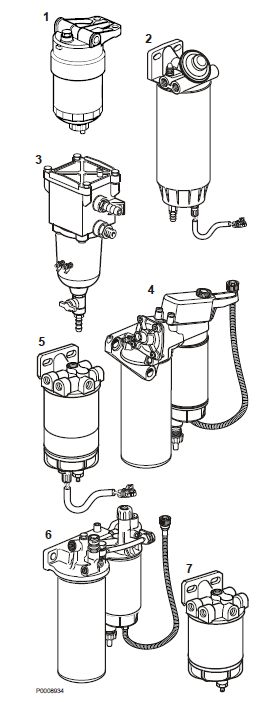
Water separating primary filters are engine-mounted on D9, D11, D13 and D16 engines as standard. The filters 4, 5 and 6 have replaceable filter cartridges and water-in-fuel alarms. On D9 and D16 engines, water can be drained through the valve in the bottom of the water separator. Filter category 30 microns. There is a water separating pre-filter without a waterin- fuel alarm available as an accessory for engines in the series with mechanical injection pumps. Filter category 30 microns (figure 7).
Modern common rail engines
Some common rail engines uses this filter. For filter categories, refer to technical data in the Sales Support Tool, Partner Network.
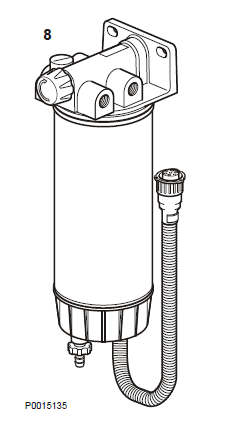
Fuel Cooler
If the fuel temperature exceeds the maximum applicable temperatures specified in technical data, a suitablydesigned fuel cooler must be installed on the engine return line. This is to avoid unnecessary fuel tank heating and an increased pressure drop on the suction side. Heat can only be conducted away from fuel satisfactorily and in controlled circumstances by using a suitably- designed fuel cooler. Such fuel coolers should preferably be built into the engine cooling system (air side) and be fed with return fuel. Recommended maximum flow resistance on the fuel side of the fuel cooler is <0.15 bar at a fuel flow of 7-10 l/min.
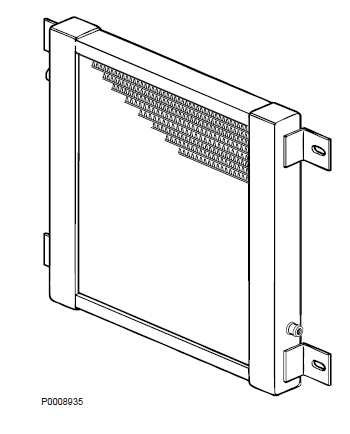
Fuel Hand Pump
TAD520 – TAD760
We recommend the installation and use of a manual fuel pump. Manual fuel pumps must always be installed if tank average fuel level is below the fuel pump. The manual fuel pump should always be installed in an easily accessible place between the tank and the fuel filter inlet. The fuel pump must always be installed upright (refer to illustration) so that fuel is fed from below.
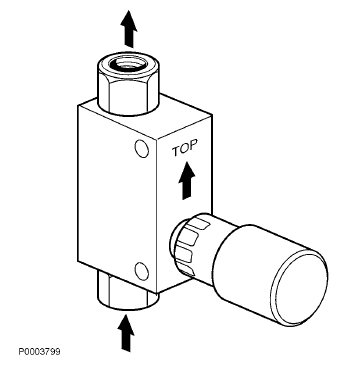
Fuel Tanks
Fuel Tank Design
Preferably, the fuel tank should be manufactured in HDPE polyethylene, stainless steel or sheet steel, and may not be painted or galvanized internally. Copper sheet, galvanized or hot-dip zinc sheet metal and aluminum are not suitable as fuel tanks for today's diesel standard with admixtures of FAMA type biodiesel. Sheet metal tanks must be welded, and on mobile installations they must be fitted with baffles to prevent fuel sloshing around in the tank. The baffles also act as supports. See adjacent illustration.
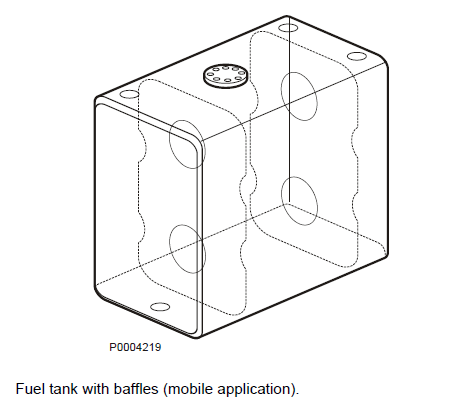
Fuel tanks must be equipped with:
- A ventilation tube at the top of the tank and a filter for dusty environments; see figure 1.
- The ventilation at the top of the tank must allow circulation in both directions.
- A filler opening and a fuel gauge or sight glass. In difficult environments, "pure filling" must be considered.
- A drain tap at the bottom of the tank for draining water and sludge.
- A ground wire (1) between the filler opening and the tank ground connection; refer to fig. 2.
- A fuel suction line (A) located 40 mm (1.57") above the bottom of the tank to prevent sludge and water entering the fuel supply; see fig. 3.
- A distance of at least 500 mm (19.7") between the fuel suction line and the fuel return line (B) in order to avoid direct recirculation of hot fuel. See fig. 3.
- If the above is not possible the fuel return line must face away from the fuel suction line at a distance of at least 150 mm (6"); see fig. 3.
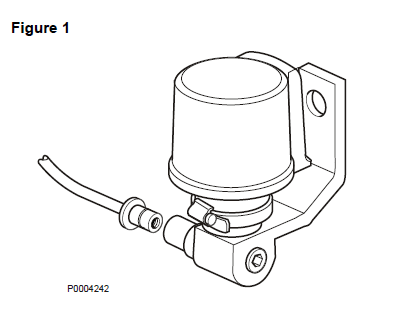
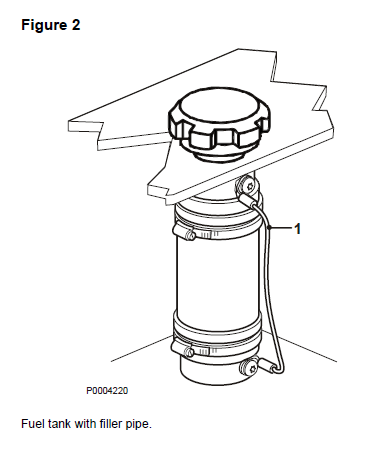
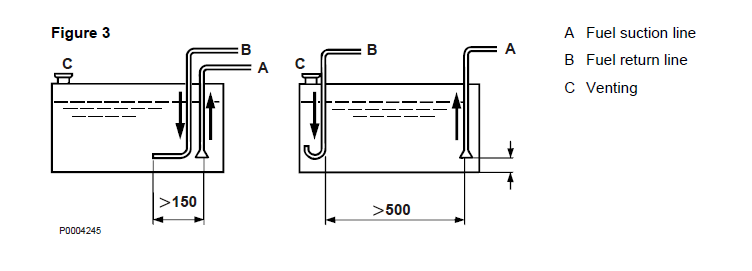
Fuel Tank Location
The fuel tank must be located in relation to the engine so that the values in Sales Support Tool, Partner Network for the engine concerned are not exceeded. Fuel pump suction height capacity is calculated from the bottom of the tank. If the tank is located below the maximum suction height, or the tank cannot be located sufficiently close to the engine, a day tank must be installed at a suitable distance and height. There is usually an automatic transfer pump that fills the day tank from the storage tank. Refer also to the Arrangement and Planning page 14 chapter. Day tank design must fulfill the same requirements mentioned in the fuel tank design section. If the inlet temperature exceeds the maximum value in technical data the fuel must be cooled.
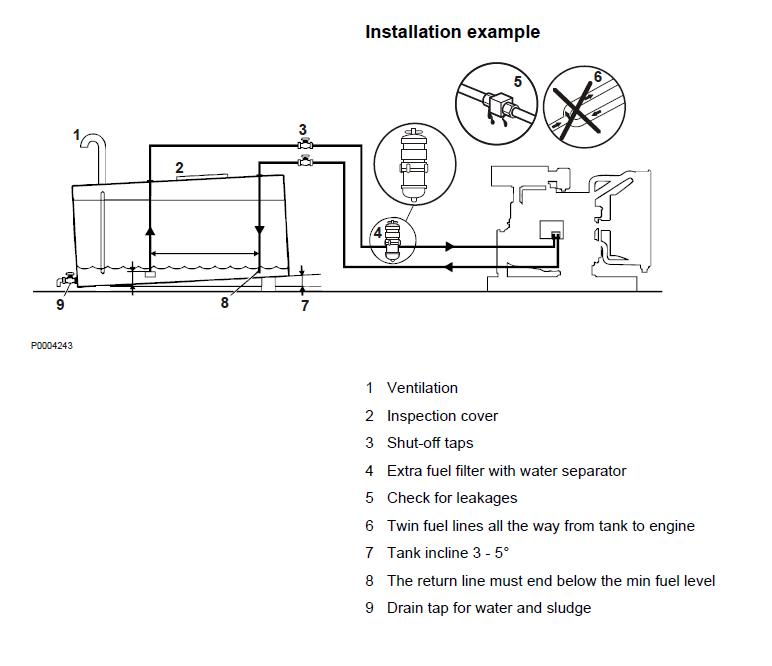
If the maximum fuel level in the tank is above the engine cylinder head a shut-off valve must be installed in the fuel line to prevent fuel from running back and mixing with lubricating oil while the engine is at rest. A suitable shut-off valve is available from Volvo Penta. We recommend that stand-by gen set tanks always be located such that the maximum fuel level does not reach above the level of the engine cylinder head. In this way the engine always has optimum fuel while dilution of engine lubricating oil is avoided. Fuel tank location in the installation is important on engines which reaches high fuel temperatures. The tank must be designed and installed so that heat radiation to surroundings is maximized, i.e. a tall, narrow tank with a large surface area facing toward the outside of the application, away from hot airflow from the fan and the high engine compartment temperature. The fuel tank must not be located next to e.g. a hot hydraulic oil tank. We also recommend some form of heat insulation or heat shield.
For More Volvo Engine workshop information, please visit
Volvo Engine Insulated Exhaust Systems
Copyright © Guangxi Dingbo Generator Set Manufacturing Co., Ltd. All Rights Reserved | Sitemap
Update cookies preferences